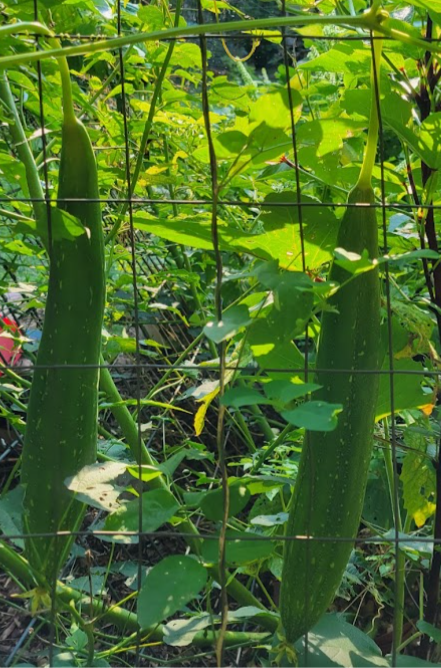
Luffa Gourd
This gourd is good for a natural sponge and dish scrubber cloth. The young gourds are edible and taste like okra.
|
Unknown |
|
Luffa aegyptiaca |
|
Easy to Intermediate |
|
Intermediate |
|
4 years if properly stored |
|
Annual |
|
Slow. It can take up to 3 weeks. |
|
75-90 F |
|
None |
|
1 inch |
|
Vine |
|
Full sun |
|
130 days |
|
April and May |
|
Yes |

Picture by Grace Woods. Used with permission.
Growing Tips


When to Start
Indoor Start: Three weeks before the last frost. (April 1-10 for Jefferson, GA)
Direct Sow: Direct sow in long-season growing areas (like Jefferson, GA) After the danger of frost has passed and once the soil temps have reached 70 F.
How to Grow
In areas that have a shorter season, start seedlings indoors 3 weeks before the last frost. In longer-season areas, direct sow after all danger of frost has passed and soil temperatures have reached at least 70 F. Sow to a depth of 1 inch. According to Rareseeds.com birdhouse gourds have spotty germination. Plant several seeds and then thin them if needed. Germination can take up to 3 weeks.
Care
Luffa gourds prefer well-draining soil and full sun. Space or sow plants 18-24 inches apart. These are big vines that will take over an area. They can be trained up a trellis to help conserve space and make harvesting easier.
These gourds need lots of water. Keep the soil moist but not soggy and don’t let the soil dry out. A trellis is highly recommended for growing these gourds. The gourds should hang and grow straight on a trellis. Apply a thick layer of much to suppress weeds and retain soil moisture. Trellises will help keep the gourds up off the ground as they are prone to rotting if touching the ground. The rest of the care requirements are identical to squashes.
Like squashes, these gourds produce male and female flowers on the same vine. Unlike squashes, let the vine grow to the desired height and then prune or tip it to encourage lateral branching.
Harvest
Young fruit can be harvested and eaten like okra.
For sponges, harvest the mature fruit before it has dried out when it is still green in color but has developed a tough skin. This is usually AFTER the first frost.
Making a Sponge
After harvest, remove the hard outer skin. Then shake the seeds out by beating the sponge on a hard surface. It might be good to do this step outside and the seeds tend to fly everywhere. Then soak the sponge in warm soapy water to remove any particles and disinfect it. You can also use bleach, but it’s not necessary. Then rise and dry the seedless sponge. After drying it can be cut to the desired size to be used as dishcloths, luffas, or scrubbers.
Seed Saving

Isolation Distance
Isolate different varieties by 1/2 mile.
Instructions
Harvest fruit before it has dried out when it is still green in color but has developed a tough skin. Cut the gourd and scoop the seeds out to dry. Once the seeds a dry store them in a cool dry place.
Features
- Good for eating (when young)
- Good for sponges, luffas, and cleaning.

Use a trellis to keep the fruit off the ground. The gourds are prone to rotting when touching the ground.
Sources:
1. Kondo, Ebi “Birdhouse Gourd, Lagenaria siceraria” Denver Botanic Gardens, 1 November 2021, https://www.botanicgardens.org/blog/birdhouse-gourd-lagenaria-siceraria#:~:text=Growing%20birdhouse%20gourds%20is%20very,well%2Ddrained%2C%20fertile%20soil.
